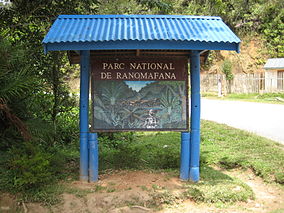This article needs additional citations for verification. (August 2022) |
| Ranomafana National Park | |
|---|---|
 Entrance sign to Ranomafana National Park | |
| Nearest city | Fianarantsoa, Ranomafana |
| Coordinates | 21°13′S 47°25′E / 21.217°S 47.417°E |
| Area | 416 km² |
| Established | 1991 |
| Governing body | Madagascar National Parks Association |
| Type | Natural |
| Criteria | ix, x |
| Designated | 2007 |
| Reference no. | 1257 |
| Region | List of World Heritage Sites in Africa |
Ranomafana National Park is a national park in southeastern Madagascar, in the Haute Matsiatra and Vatovavy regions. It was established as Madagascar's fourth national park in 1991 following the rediscovery of the greater bamboo lemur (Hapalemur simus) and the discovery of the golden bamboo lemur (Hapalemur aureus) by the primatologist Dr. Patricia Wright.[1]
The park protects more than 41,600 hectares (161 square miles) of tropical rainforest at elevations ranging from 800 to 1,200 m (2,645 to 3,937 ft) and is home to several rare species of plants and animals.[2] It was later integrated into the UNESCO World Heritage Site Rainforests of the Atsinanana.[3] The Centre ValBio research station is adjacent to the park and was created in 2003 by Stony Brook University for biodiversity research, community health and education, environmental arts, and reforestation.[4]
The park's name is derived from the Malagasy words rano mafana ("hot water") due to the hot springs in the nearby town of Ranomafana.[1]
- ^ a b "Ranomafana National Park | Centre ValBio". www.stonybrook.edu. Retrieved 2023-01-20.
- ^ "Ranomafana National Park (Official GANP Park Page)". national-parks.org. Retrieved 2023-01-20.
- ^ Centre, UNESCO World Heritage. "Rainforests of the Atsinanana". UNESCO World Heritage Centre. Retrieved 2023-01-20.
- ^ Centre ValBio
